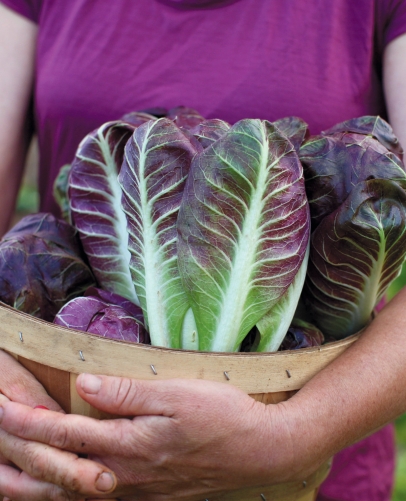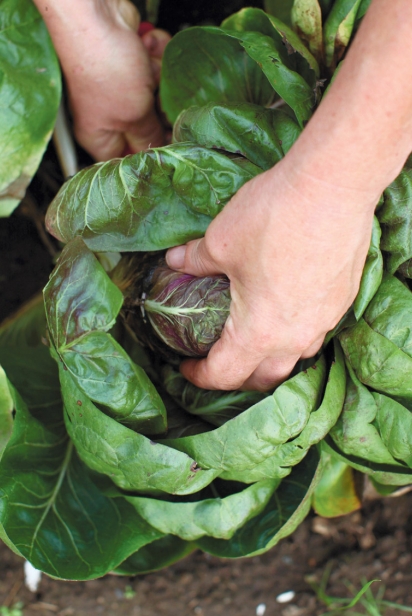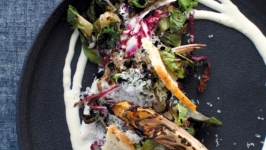Growing a Love for Chicories
A Case for Embracing Bitterness
From the deep burgundy of radicchio to the lacy frilled edges of frisée, chicories bring stunning color and texture to every plate they grace, though their bitter flavor leaves many home cooks at a loss. The chicories many of us know today—radicchio, endive, frisée and escarole, to name the most popular—descended from foraged wild greens and weeds, and despite their cultivation, they have maintained their distinct bitterness.
This is in direct opposition to many vegetables, especially lettuces, which have been cultivated and bred to reduce their bitterness. “Without bitterness we lose a way to balance sweetness,” writes Jennifer McLagan in her book Bitter (Ten Speed Press, 2014), “and by rejecting it we limit our range of flavors. Food without bitterness lacks depth and complexity.”
It is worth remembering that some of our very favorite foods, the ones we search the globe far and wide to find, fall under the bitter category, including coffee and dark chocolate, not to mention hops, used to make beer, and bitter alcohols, essential to so many popular drinks, including a good Manhattan.
Taste remains the least understood of our senses, and one reason for that may be the many factors that go into building a person’s sense of taste. There is the science behind taste buds, but then there is the environment in which our tastes are shaped, so to speak, which includes family, culture, exposure and experience. While other culinary cultures, especially Italian and Asian, embrace and enjoy bitterness, North American palates tend toward sweet.
Farmer Diana Kushner of Arcadian Fields is on a mission to help home cooks embrace chicories in all their bitter glory. Diana has carved out space, tucked among the rows of more well-known and loved greens, to grow more varieties of frisée, radicchio and escarole every year.
They can be challenging to grow: Their tight leaf structure makes them susceptible to rot, and because they haven’t been domesticated for long, they are also susceptible to damage from insects and weather fluctuations. Still, Diana perseveres. “It takes a personal introduction to chicories to convert home cooks, and even chefs,” she says. “I don’t think most people know what to do with them.”
Diana has been known to give away heads of radicchio and frisée in an attempt to win over her customers. She also suggests simple yet delicious preparations such as her personal favorite, radicchio salad. “Simply toss sliced radicchio with a dressing of olive oil and cider vinegar, and top with toasted nuts or seeds, feta, roasted red onion and something sweet like apples or dried cranberry. You can also throw in some arugula, fennel or frisée to round out the flavors.”
Diana also loves to roast radicchio by sautéing red onion until almost caramelized, and then tossing in the radicchio, roughly chopped, and putting the whole dish in the oven for 10 to 15 minutes. “Roasting really brings out the natural sweetness often overlooked in radicchio.”
When asked why she keeps devoting precious space to a crop that isn’t an easy sell, Diana references the heirloom tomato. “I remember a time when no one would buy a yellow or purple or lumpy tomato. Now people can’t get enough of heirloom varieties. The more interesting and colorful, the better.” She views it as her responsibility to introduce consumers to forgotten flavors and varieties. “How do new foods and flavors get introduced to people?” Diana asks.
“The answer is through independent, small seed companies and small farms, such as mine. There have to be people doing the work of rediscovering and reintroducing lost varieties.”
While many chefs need a nudge to give chicories a chance on their menu, Chef Gina Pezza of Vanda Cucina in Warwick embraces cooking with bitter greens. “I like to compare chicories to a cup of coffee,” Gina says. “Alone, a black cup of coffee is inherently bitter. But with a few additions— cream, sugar or a lemon peel on the rim of an espresso cup—the coffee suddenly becomes balanced, rich and delicious. The same principles apply to cooking with chicories,” she goes on to explain. “It all comes down to balancing salt, sweet, sour [acidity] and fat.”
Gina points out that chicories come in all shapes, sizes and colors, so the possibilities are numerous, and she suggests trying different methods of preparation, from a quick char on the grill to a gentle braise. “All applications can completely change and elevate your dish,” Gina notes. “I might choose radicchio and keep it raw because of its vibrant color and sturdiness, then toss it last minute in a full-body/full-fat sauce. Braising endive is also a favorite of mine. It helps break down the leaves, which produces a sweeter, mild bite and removes much of the bitterness.” She pairs the braised endive with fennel, onion, leeks and a tomato sauce for a warm and hearty dish.
Added last minute to soups and stews, chicories cook quickly and brighten up the flavor. Escarole is popular in many Italian and Portuguese soups for that very reason. Their bitter taste also complements rich meats like pork and duck.
Their versatility in cooking is just one of many reasons to incorporate bitter greens into your diet, another being their health benefits. McLagan, in Bitter, explores the health benefits of bitter foods in great depth, beginning with the Egyptians, who made medicinal drinks by steeping bitter plants in alcohol to extract their beneficial compounds. Plants that retain bitterness are found to have more healthy phytochemicals. “Some are antioxidant, protecting our tissues from damage and disease,” explains McLagan, “some are anti-inflammatory or analgesic, easing our pain; some are antipyretic, or fever reducers; and some are multifunctional, delivering more than one of these benefits.” These compounds abound in foods such as cardoons, chicory, arugula, dandelion, red wine, tea, citrus, walnuts, olives and cocoa beans.
If the world of bitter flavor is calling you to explore further, be sure to pick up a copy of Bitter, chock-full of fascinating research and delicious recipes. More importantly, take Diana’s advice to heart: “As you wander your farmers market and see a head of radicchio or frisée, just try it. They are worth trying.”
Although her farm may well be lying still and silent under a blanket of snow as you read this, she’s curled up inside with a seed catalog, excitedly flagging down new varieties of chicories to try next season. There is no off-season when you are helping to introduce new flavors to a skeptical crowd.







